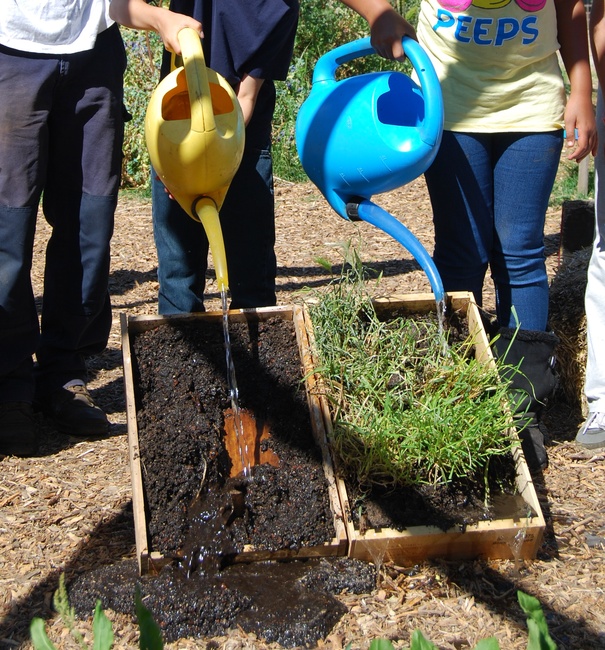Garden Science: Soil and Erosion

Summary
In this sixth grade science lesson, students will learn the main components of soil and discuss how soil is created in nature as well as how we can conserve it in the garden.
Objectives
After this lesson, students will be able to:
- List the components of soil: parent material (i.e. sand), clay/silt, and organic matter.
- Explain weathering.
- Recognize erosion and give examples of ways in which we keep topsoil from eroding in the garden.
Assessments
During this lesson, students will:
- Identify the different components in soil.
- Define physical weathering.
- Observe and explain the erosion demonstration- how erosion occurs and how erosion can be prevented.
Materials
Opening Circle
- Canvas bag
- In separate jars:
Clay/silt
Sand
Organic matter
Water
Air
- In separate envelopes:
Definition of weathering
Definition of erosion
Erosion Demonstration
- Crate with grass sod
- Crate with soil only
- 2 watering cans: one for each simulated hillside
Before You Begin
- Gather opening circle materials and put in canvas bag
- Cut out 1 foot x 1 foot block of grass for erosion demo and place in crate or tray
- Fill a separate crate or tray of equal size with soil
Procedures
At the Opening Circle
- Welcome students and hold up the bag of soil ingredients. Explain to students that the bag holds the essential components to Today’s topic: something we all rely on to live.
- Explain that in opening circle, we will put our heads together to come up with the topic of the day by uncovering the contents of the bag one by one.
- Pick students at random to pick out a jar from within the bag.
- Once all the jars have been passed out have students explain the contents of each. Begin with organic matter, sand and clay.
- Re-state the contents: Organic Matter, Sand, and Clay. Ask students what they think these three ingredients make when they are all together. (soil)
- Prompt students to think about how the ingredients stick together and become living soil (air and water).
- Focus attention to the jar of sand and guide discussion towards weathering by prompting students to think about how sand is created.
- Hand the envelope labeled “Weathering” to a student and ask him/her to reveal the definition.
- Now that students know that sand is weathered rock, ask students what they think clay/silt is (smaller particles of weathered rock).
- Recap the essential components to Soil by having students repeat in chorus: Organic Matter, Sand, Clay, Water, and Air.
- Challenge students to re-state loud and fast.
- Refer to the opening statement of needing soil to live. Ask students why soil is essential to life.
- Challenge students to come up with a food they have eaten in the past week that did not come from soil.
- While taking examples, encourage students to trace the food back to soil. Example: Burger- the meat comes from a cow that ate grass from the soil and the bun comes from wheat that grows in soil etc.
- Explain that in closing circle, students will learn about erosion- a potential threat to our topsoil-, and how we can conserve our soil by preventing erosion in the garden.
- Explain garden groups and break-up into working groups
Closing Circle
- Set both trays tilted upwards to simulate hillside A: a forested hillside and hillside B: a bare hillside
- Ask for a volunteer to define erosion in his/her own words.
- Hand the envelope to the student volunteer and ask him/her to reveal
- the definition to the whole class by reading aloud.
- Set the scene of hillside A and B
- Ask students to generate a hypothesis of what they think will happen to both hillsides after a storm hits.
- Ask for two volunteers to simulate the rain by pouring the water from the watering cans onto the tilted trays.
- Ask for the class to simulate the sound of thunder by drumming on their thighs with their hands.
- Once all the water has been poured out of the watering cans, have volunteers return to their seats.
- Ask students to describe what happened to hillside A and hillside B using the new term Erosion.
- Ask for examples of ways that erosion is prevented in the garden. (mulch, planting trees on the hillside, filling up garden beds etc.)
- Prompt students to think about where soil goes when it erodes.
Vocabulary
Soil
Weathering
Chemical Weathering